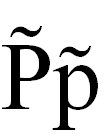P̃
Latin letter P with tilde From Wikipedia, the free encyclopedia
P̃ (majuscule: P̃, minuscule: p̃) is a Latin P with a diacritical tilde. It is or was used as a grapheme in some languages of Vanuatu, such as North Efate, South Efate and Namakura, to represent a sound [k͡p], like the ⟨c⟩ in "cat" and ⟨p⟩ in "pay", pronounced simultaneously. It is also used in the Yanesha' language.
This article relies largely or entirely on a single source. (January 2025) |
| P with tilde | |
|---|---|
| P̃ p̃ | |
 | |
| Usage | |
| Writing system | Latin script |
| Type | Alphabet |
| Language of origin | Yanesha', languages of Vanuatu |
| Sound values | [k͡p], [pʲ] |
| In Unicode | U+0050, U+0070, U+0303 |
The letter was introduced by missionaries and has been in use for over a hundred years.
In Bislama, the lingua franca of Vanuatu, p with tilde is called snekpi "snake-P".
In Old English, it was used as a contraction of the penny, as in ⋅cxx⋅ p̃. ("120 pence").[1]
Computer encoding
Unicode encodes p with tilde with a combining diacritical mark (U+0303 ̃ COMBINING TILDE), rather than a precomposed character. As such, the tilde may not align properly with some fonts and systems. In standard HTML code: majuscule P̃, minuscule p̃. The Unicode HTML hex code is: minuscule p̃, majuscule P̃. The Unicode HTML decimal code is: minuscule p̃, majuscule P̃.
References
Wikiwand - on
Seamless Wikipedia browsing. On steroids.